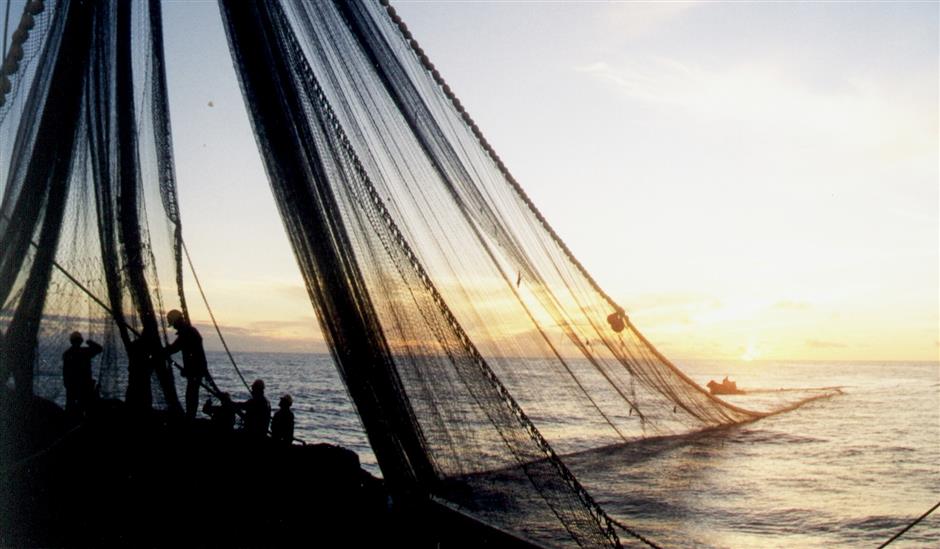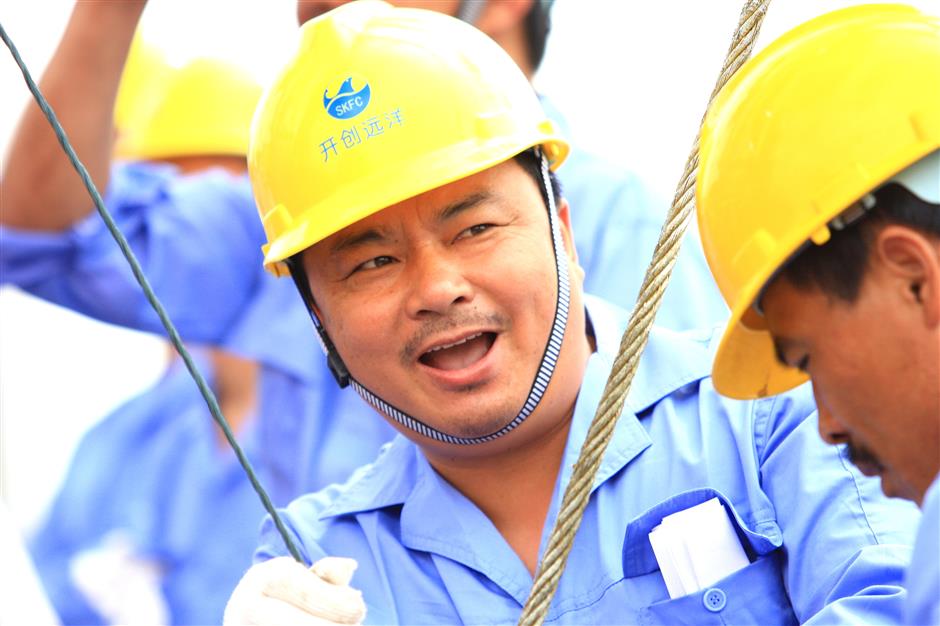On the high seas, modern fisherman hauls in the catches

At home, Jin Weiguo wakes up in the middle of the night. It’s his sea-clock to blame. He gets up long before dawn when at sea.
Jin, 49, is a chief captain for Shanghai Kaichuang Deep Sea Fisheries Co. He spends six to eight months every year fishing tuna in the western and central Pacific Ocean.
His contributions to the Chinese tuna-fishing fleet earned him an honor last year as a “Shanghai Standout,” an award for excellent workers.
His fishing fleet operates in an area of the Pacific that accounts for about half of all tuna caught in the world’s oceans every year.
Tuna-fishing vessels from the Chinese mainland, which use nets called seines to haul in the fish, were late-comers in that area of the Pacific when they arrived almost 20 years ago. Trawlers from the United States, Japan, South Korea and China’s Taiwan Island already were plying those waters.
The Chinese mainland fleet, mostly from the Shanghai company, has grown to 10 vessels from four in that time.
Jin became the first captain from the mainland on a Chinese seine-fishing vessel for tuna in 2003.
“Tuna fishing is 30 percent luck and 70 percent equipment and techniques,” he says.
The captain’s job is to spot fish and work out the best ways to catch them, based on data analysis of winds, waves, weather and other “intelligence” collected by technological instruments.
Before venturing into the open sea, Jin had a decade of experience seine fishing in coastal waters, but tuna fishing was a new challenge because the working environment is entirely different.
“Some captains plan where to go only a day in advance, but I often plan for up to a week ahead,” he says.
That means anticipating where large schools of tuna may gather.

Jin Weiguo, 49, a chief captain for Shanghai Kaichuang Deep Sea Fisheries Co
In seine fishing for tuna, a vessel and two boats work together. The vessel and a larger boat spread the net, and a smaller boat drives the fish into the net. The net, at its largest, forms a circular area 700 meters in diameter, which is about 200 standard soccer fields.
Instead of meeting the tuna with the net from the opposite direction, Jin says he prefers to chase them from behind so the net won’t be broken as easily. But that technique requires precision in execution.
Jin and his sailors have learned the hard way what happens when nets tear. Mending them on deck under a scorching sun is difficult work. Jin still remembers the time in 2016 when it took the crew five days to mend a net.
Being captain involves endless hard decisions.
“Last year, I once had to let 150 tons of tuna go because the water was too fast and I was afraid that the net wouldn’t withstand it,” he says. “But that was still better than having to stop work for a few days to mend a torn net.”
The job also requires infinite patience. Spreading a net takes 90 minutes, and that doesn’t guarantee a catch. Tuna are known for their elusiveness.
Jin recounts one of his largest harvests in one net, back in the summer of 2007.
“I failed twice laying a net toward the northeast and southeast, and it was high noon when I laid it to the southwest,” he recalls.
From afar, Jin saw the sea heaving — a possible sign of a big school of fish. The crew netted 220 tons of yellow-fin tuna that day.
When working at sea, Jin gets up at 3am and works until six or nine at night. Last year, Jin and his colleagues began using light to attract tuna to the net at night. At daybreak, a small boat with a light takes over the net while the vessel sails a kilometer away, turns, and then goes at full speed to haul up the fish.

Jin Weiguo at the helm
This method has significantly increased the annual fish haul. Jin says it depends on timing, light and temperatures and doesn’t work every night.
Fishing sea isn’t as dangerous as some people imagine, but accidents do occur. The mast on a vessel once fell over. It would have killed sailors had they not jumped into the sea.
After that, the crew secured the 20-meter-high, 10-ton mast with steel wires to prevent further accidents.
For every sea trip, Jin and his crew members only need to grab a bag and go. Everything they need for daily life is available on the vessel. Food is abundant, although the vegetables are always wanting and frozen meat tastes like paper, Jin says.
In the first few years of work, Jin returned home once every two years. His wife complained that he missed Chinese New Year with his family for nine years.
“Life is adaptation, and my family has adapted to my long absence from home,” Jin says.
The company has a 10-year-old association of family members of fishing crews to act as shore support. Its labor union shoots videos of the crew at sea for family members to watch.
















